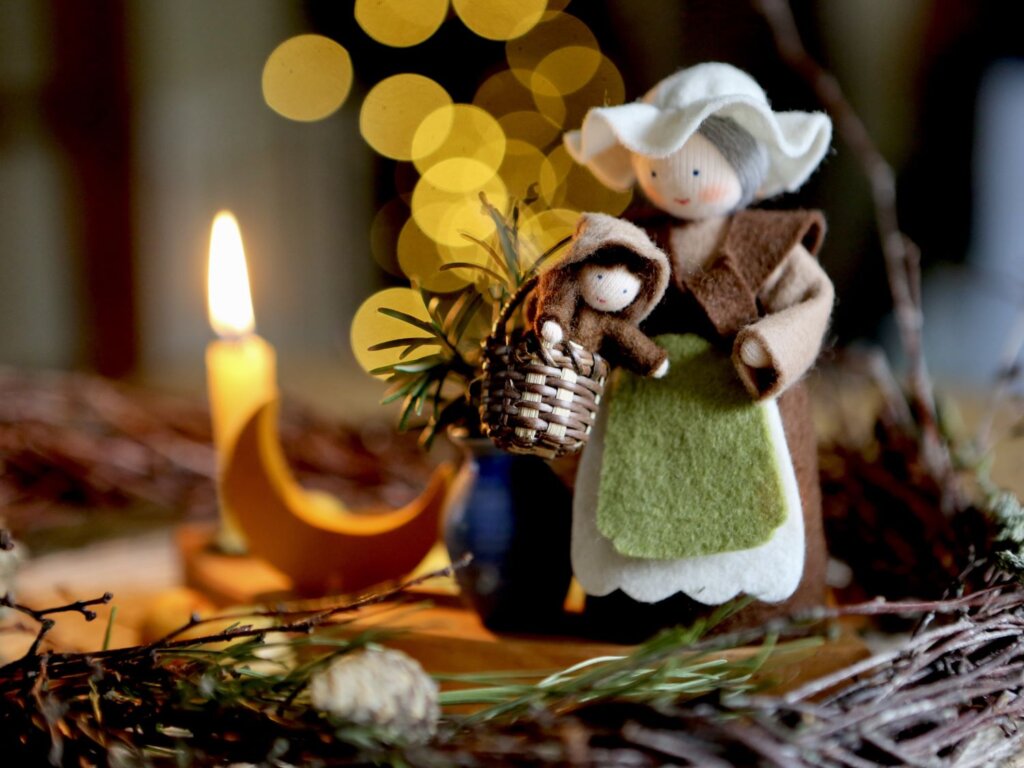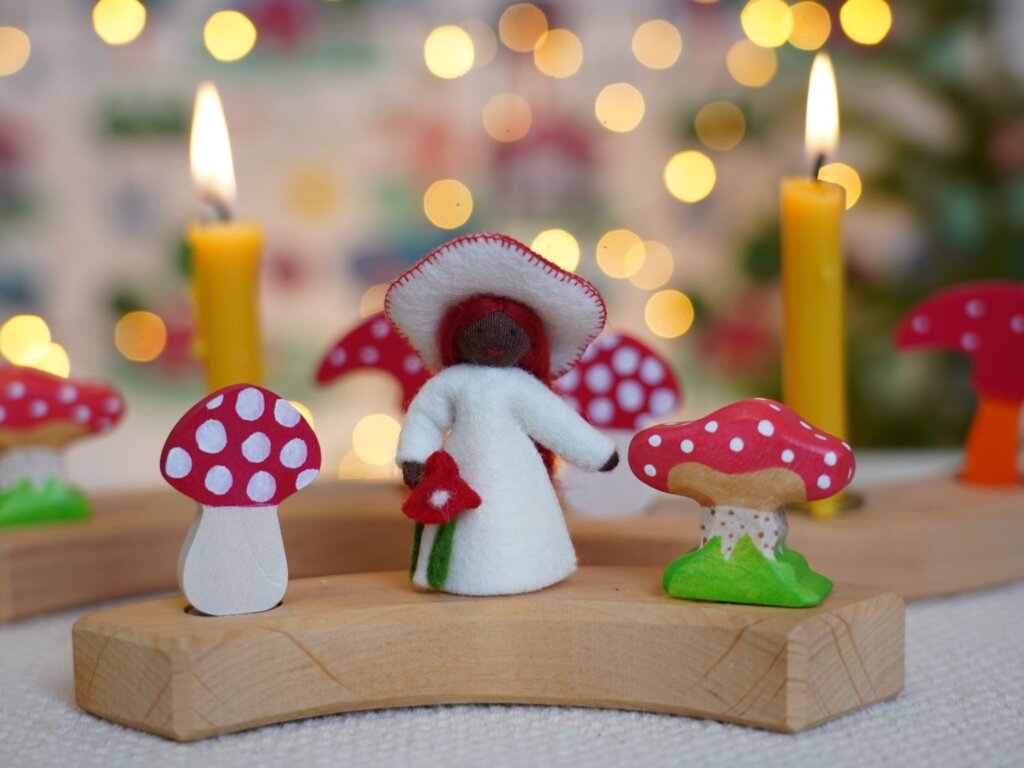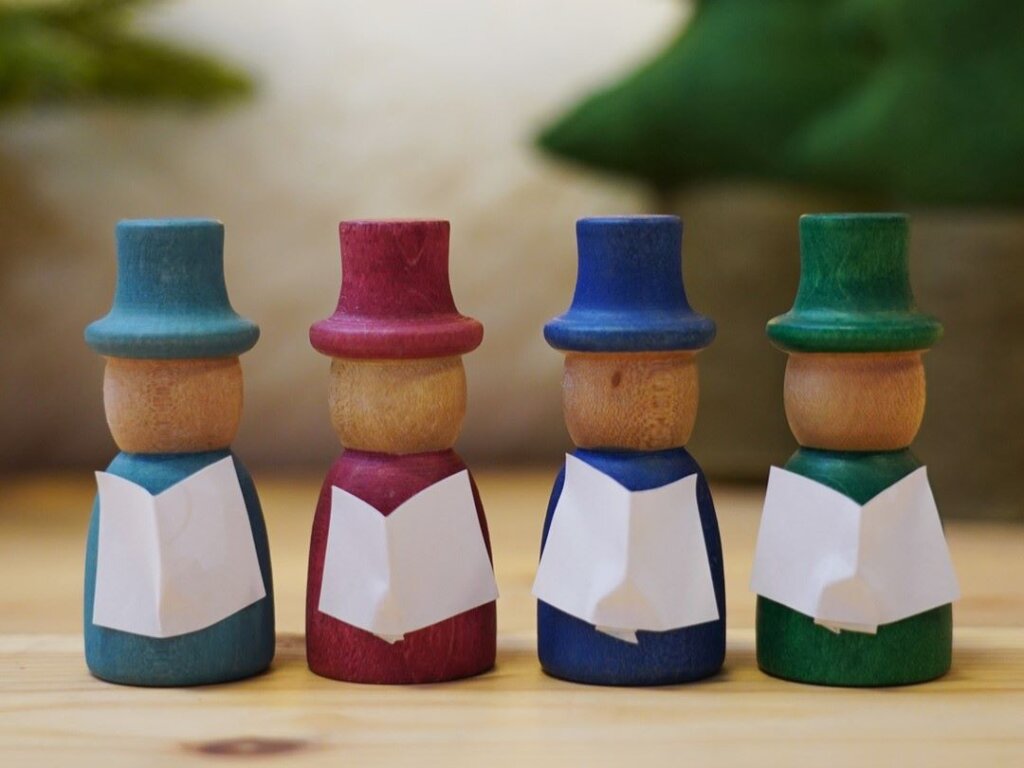
Celebrating Yule
Yuletide blessings! Yule is a 12 day long celebration that starts on the eve of the Winter Solstice in the Northern Hemisphere and ends with the new calendar year. This celebration was one of the most important of the year in ancient times, celebrated by Pagans across Europe.
In essence, Yule marks the return of the sun after the long dark nights of winter. The word Yule comes from the old Norse word for wheel. It reminds us of fresh starts and the cyclical nature of our planet. It's naturally a time of year where we reflect on the year passed, and our plans for the year ahead. Many Yuletide traditions are very familiar from our Christmas celebrations, including singing, lighting candles, decorating homes, feasting, dancing, and sharing gifts.
Many of these traditions are not fixed to a particular day. They are drawn from across Europe being kept alive by communities through stories, song and verse. Here are some ways to incorporate Yuletide celebrations into your festivities.
Mother's Night - The First Day of Yuletide
On the eve of the Winter Solstice, Mother's Night, we light candles to honour the women that came before us.
The official beginning to Yule celebrations Mother’s Night, or Mōdraniht in Old English, is a day to offer thanks to our female ancestors and tell their stories. It’s believed they watch over our families and help us in times of need. To celebrate Mother's Night many people bake cookies. This could be a treasured family recipe or a favourite biscuit from the region your female ancestors are from .

Winter Solstice - The Second Day Of Yuletide
The Winter Solstice is a festival of light, usually falling on the 21st December, marking the beginning of astronomical winter. The sun has reached the lowest point in the sky and for a few brief days, daylength appears to pause. This is a significant time in the calendar for many cultures, celebrating rebirth and the slow return of the light as the wheel of the year turns.
Winter Solstice or Yule celebrations date back millennia. Many of our modern traditions have their roots in Celtic and Druid customs. Decorating our homes with evergreen plants like holly, ivy and mistletoe, burning yule logs and making wreaths have there roots in Winter Solstice celebrations.
Traditionally a Yule log is burned in the hearth for twelve days over the Winter Solstice. This was to encourage the sun to move and bring back warmer, longer days. A small piece of charred wood would be kept back to start the fire the following Yule.

Mistletoe - The Third Day Of Yuletide
The tradition of bringing evergreen plants into our homes stemmed the ancient Druids. They looked to all things that bring light and life in the dark winter months, including holly, ivy, pine and mistletoe.
Mistletoe is a hemiparasitic (partially parasitic) plant, which grows in the branches of a host tree. This slow growing plant is often found in old apple orchards. The Mistle Thrush feasts on the berries and spreads the seeds from tree to tree.
These days, mistletoe is mainly associated with the tradition of kissing beneath it, with the promise of love. However, Mistletoe also holds symbolism for fertility, for luck, for peace and for strength. When hung in the doorway it's said it will ward off evil spirits and offer protection from lightning.

The Deer Mother - The Fourth Day Of Yuletide
Have you ever wondered how the sun returns to the frozen North in Spring? We have a special winter folk story to share with you for the 12 days of Yuletide from Northern Europe.
Across the frozen lands of Northern Europe comes the folk tale of the Deer Mother. The Sami people of northern Scandinavia have honoured and revered reindeer for centuries. There lives are intertwined and dependent on following these great herds. The oldest matriarch reindeer leads the herd, and only the females retain their antlers over winter. In ancient Britain the Deer Mother was known as Elen of the Ways...

The Story of Elen of the Ways
In a clearing in the vast frozen forest, all the animals from the biggest bear to the smallest mouse huddled together for warmth, the ice driving them from their winter slumber.
The great bear declared that the sun needed to be brought back to the northern lands from the south, or all the animals would perish from the cold. This would take huge strength and courage. Only the Reindeer mother stood forward to take on this challenge. She was used to travelling vast distances and, with her branching antlers, could safely bring back the sun from the south.
She set off through the forest and came across an old man as ancient as the woods in a cloak of evergreens carrying a large sack. He could see the Deer Mother was tired and her journey long. Reaching into his sack he brought out a mushroom with a red cap and white spots, prized by the reindeer. She ate the mushroom and went on her way, faster and faster until her feet left the snow and she was flying through the night sky.
The Deer Mother found the Sun Goddess in the southern lands, too exhausted to travel. Lowering her head the reindeer invited the Sun Goddess to travel with her back to the northern lands where she was so desperately needed. She climbed up into her antlers and away they flew to the north, bringing light and warmth back to the frozen lands.
There are several variations of this ancient tale which forms part of winter solstice celebrations in Northern Europe - a tale of courage, hope and a touch of magic.

Santa - The Fifth Day Of Yuletide
There’s lots of stories about the origins of Father Christmas. Many link modern day Christmas traditions with the ancient cultures of the northern people. St. Nicholas, the patron saint of children, was a generous bishop known for giving gifts to the poor. He sported the beard and a long cloak similar to the modern day Father Christmas we know and love.
But even before St. Nic, the ancestral people of the Arctic celebrated the Winter Solstice with the help of the sacred mushroom Amanita muscari or the Fly Agaric. A favourite food of reindeer, they grow in a symbiotic relationship with the birch and pine trees. Some legends say their properties allowed shamans to travel to the spirit world, returning back with gifts on the backs of flying reindeer. The red and white capped mushrooms were collected and dried on the branches of evergreen trees, much like our modern Christmas Trees, and given as gifts.

Christmas Tree - The Sixth Day Of Yuletide
Bringing evergreens into the home has long been part of Yuletide traditions, symbolising the renewal of life. However, it wasn't until the Victorian era that that whole trees have been brought into our homes. Prior to this in Eastern Europe a large fir branch or top was suspended from the ceiling above the table and decorated with dates, apples and paper flowers.
The legend of the Christmas Spider is associated with the folklore of Western Ukraine and Germany. This tale offers a hint at the origins of tinsel. According to legend, a hardworking widow and her children couldn't afford decorations for their Christmas tree. However on Christmas Eve, while the children slept, a spider spun webs around its branches. When the children awoke on Christmas morning, they opened the curtains and the first rays of sunlight turned the webs into strands of silver and gold. It's believed in many parts of Europe if you find a spider web in your home at Christmas it's a sign of good luck!

The Christmas Witch - The Seventh Day Of Yuletide
Halloween or Samhain is not the only time that is popular with witches. Traditionally, midwinter is considered a time when witches and ancestral spirits could most easily be felt.
The Christmas Witch known as La Befana comes from an Italian legend connected to the birth of Jesus. Her name derived from the Greek word for Epiphany. Legend has it that the Three Magi stopped at La Befana’s home on their way to find the baby Jesus. She tries to follow them without luck. To this day, she travels the skies on her broom looking for baby Jesus.
Stopping at each home, she flies down the chimney to leave gifts for the children including a lump of coal. Being a good housekeeper, she will sweep the floor with her broomstick before she leaves, sweeping away of the problems of the year.
Midwinter was a time for story telling, magic and casting divinations. Who better than the benevolent witch La Befana to represent this time and find her way into Christian myth.

Sing to the Trees - The Eighth Day Of Yuletide
Who loves Christmas carols? The tradition of going door to door carol singing has its roots much further back in time when folk would go Wassailing.
In medieval times, livelihoods depended on the orchards and the land producing a plentiful harvest. At Yuletide the community would go down to the orchards dressed in bright colours and decorated with ribbons and feathers. They would carry a large bowl of hot, spiced drink called wassail.
Amongst the fruit trees they would sing songs, perform plays, and sprinkle the hot drink on the roots and branches. The songs are said to wake the spirit of the trees and ward off evil spirits that may harm the harvest. This ancient ritual still occurs today, often on twelfth night in the fruit growing counties of England.

Y Fari Lwyd, Mari Lwyd - The Ninth Day Of Yuletide
The midwinter tradition of Y Fari or Mari Lwyd, is part of ancient Welsh folklore. This rather chilling figure of a grey mare is full of mischief and menace as she goes from house to house trying to gain entry.
In this Welsh tradition, the skull of a horse is placed on a pole with a white cape hanging behind her making an unsettling sight. She is often decorated with ribbons with a Christmas bauble in her eye socket, but her skull is usually left bare.
Traditionally, men would carry this eerie figure to pubs and homes where they play a rhyming game with the owners in exchange for entry. Mari Lwyd offers a verse of playful insults (pwnco) and those inside the house must respond with a rhyming insult. If the homeowners falter, Mari Lwyd is invited in for drinks, food, and mischief! The tradition of Y Fari Lwyd is still kept alive today by communities in South Wales including Llantrisant and Llangynwyd.

Elves - The Tenth Day Of Yuletide
In Scaninavia elves are traditionally known as Tomtens. These Swedish fairy folk are believed to be the spirit of the home. They offer company and protection over the long, dark winter months. However, they respond any bad behaviour by causing their own mischief!
On Christmas Eve it is the Tomtens who bring Yuletide gifts to the children. In return the Tomten gets some butter for his porridge.

Hygge - The Eleventh Day Of Yuletide
The perfect antidote to the dark, cold days of midwinter, hygge is a Scandinavian concept that's notoriously difficult to define. In essence its a feeling of cosiness and comfort in simple everyday living. Hygge is thought to have its roots in a similar word in Old Norse meaning 'protect from the outside world'.
Midwinter is the perfect time to embrace hygge. To gather with friends and family and embrace the simple things in life. Share food together, enjoy a hot chocolate, a family board game or card game, light a candle or read a book with your favourite blanket ... these are all considered hygge! So get comfy and embrace the restorative powers of the long winter months before the busyness of spring arrives.

Hogmanay, Twelfth Night – The Twelfth Day of Yuletide
Twelfth Night is the last big knees-up of the 12 days of Yuletide and coincides with New Year’s Eve! The final hurrah, the last night of the year. The season of winter merriment eventually has to draw to a close so the hard work of winter can continue. What better way to end Yuletide than with a party?
Hogmanay is the traditional New Years celebration in Scotland. Folk would work through Christmas in favour of celebrating Hogmanay. This exuberant New Year’s Eve festival included fire balls, torches, fireworks. Ringing the bells helps clear out the old and ring in the new.

Celebrating The 12 Days Of Yuletide
However you choose to celebrate the festive holiday, Team Babipur wish you a very Merry Christmas - Nadolig Llawen!








